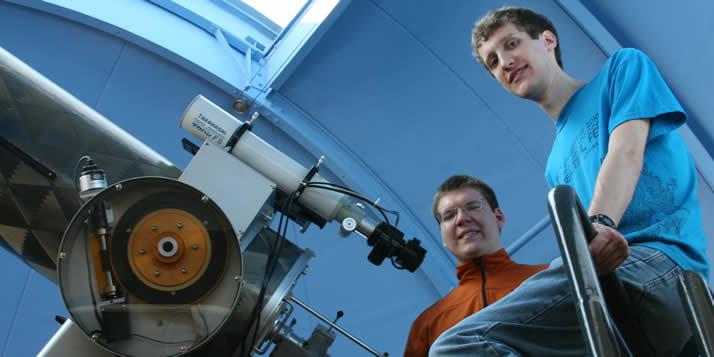Astronomy students receive NASA-funded fellowships

Sophomore physics majors Sam Van Kooten and Dan Van Noord are researching asteroids and stars through Michigan Space Grant Consortium undergraduate fellowships.
Sam Van Kooten and Dan Van Noord won’t need sunglasses this summer. But, that doesn’t mean they won’t be looking skyward. The two sophomore physics majors each received a $2,500 undergraduate fellowship from the NASA-funded Michgian Space Grant Consortium (MSGC) to continue research on asteroids and stars.
The fellowships will allow for the two physics majors—both of whom minor in astronomy—to extend their research, which they commenced as freshmen. Van Kooten’s research is titled, “Collisional History of the Koronis Zone,” and Van Noord’s, “Studies of Contact Binaries.”
Searching the stars
Van Noord is exploring star systems (contact binaries) whose stars are so close together that they are touching and might ultimately merge together. He’s hoping to learn more about how that happens.
“By us understanding the fate of the close contact systems, we can understand the fate of most binary systems in our galaxy,” said Van Noord. His research involves systematically searching through a vast catalog of 198 million stars, identifying the ones that are binaries and studying those with the shortest orbital periods.
“This helps explain how stellar evolution occurs and how it might occur differently in binary systems,” he said.
“What we are looking at here is the cutting edge of this field,” said Van Noord. “We are studying systems that we are discovering pretty much in real time, and we are learning all sorts of new things.”
Investigating asteroids
Van Kooten’s research centers on the behavior and strength of asteroids. And, while Van Noord is studying what’s happening in real time to make predictions for the future, Van Kooten’s is tracing back in time to explain why things appear the way they are now.
In the summer following his freshman year, Van Kooten wrote a computer program that computes the probability that two asteroids will collide over long periods of time and the likelihood of that collision happening at different speeds. He is now using that program to make sense of past asteroid collisional activity in one specific region of the asteroid belt.
“There is a good catalog of hundreds of thousands of asteroids in the asteroid belt,” said Van Kooten. “We can basically have a computer trace their orbits backwards in time, and when we do this, we find that sometimes a number of asteroids will all come to the same point in space at the same time. This means those asteroids are the debris from a catastrophic collision at that point and time.”
Determining how hard a collision asteroids must experience in order to break apart is the next part of Van Kooten's research. He plans work with a collaborator in Colorado who will run state-of-the-art simulations of asteroid collisions.
“These simulations have a number of parameters—tweakable ‘knobs’—regarding the strength of asteroids,” he said. “With the knobs at certain values, the simulations will tell us how hard asteroids must collide to break apart. We can combine this data with my program to find out how many catastrophic collisions the Koronis Zone (an isolated region of the asteroid belt) would have, and tweak all those knobs until the simulation’s prediction matches what we actually see in the Koronis Zone. When the simulation matches reality, we can look at the knobs’ settings and see what they tell us about the strength of asteroids.”
Enjoying research
Van Kooten and Van Noord’s recent grants are the latest enrichment to the top-level undergraduate student research at Calvin. Calvin is one of just two solely undergraduate institutions in the state to be included in MSGC. Physics and astronomy professor Deb Haarsma, who serves as Calvin’s representative on the consortium’s board of directors, understands the importance of this new partnership.
“It gives us opportunities for students and faculty to do research in space science and engineering,” she said, “and it provides funding opportunities for science outreach in the community.”
And, both Van Kooten and Van Noord are quick to point out the unparalleled opportunities at an undergraduate institution of this size.
“Calvin has a really large telescope for a college this size, and I’ve been able to work with that telescope almost since I arrived here,” said Van Kooten.
“At other institutions you wouldn’t get this kind of access to telescopes or computer time,” added Van Noord.
Both students are working with professors on their research. Van Kooten is working with physics and astronomy professor Larry Molnar, while Van Noord is researching alongside Molnar and physics and astronomy professor Steven Steenwyk. Steenwyk also received a $5,000 Seed Research Grant for "Pursuing Variable Stars of W Ursae Majoris type." (Last year professors Larry Molnar and Deb Haarsma also received Seed Research Grants.)
Van Kooten and Van Noord will be traveling with physics and astronomy professor Larry Molnar to Rehoboth, New Mexico this summer. The three will perform annual maintenance on the Rehoboth telescope (twin to the Calvin scope), which students and faculty control remotely from Calvin’s campus.






